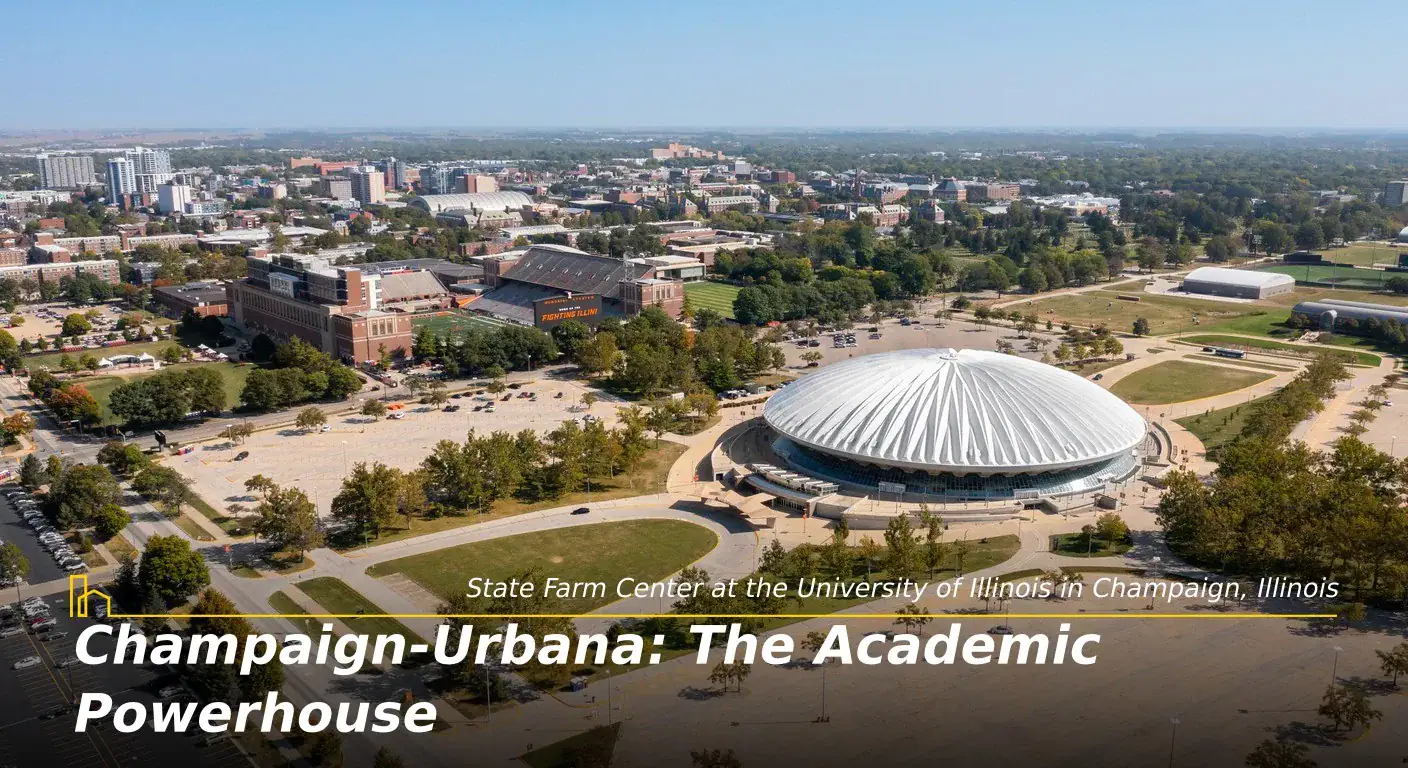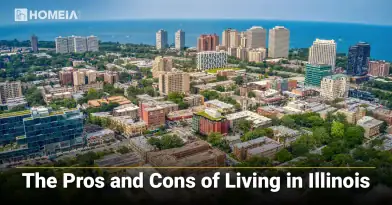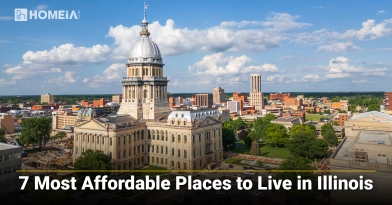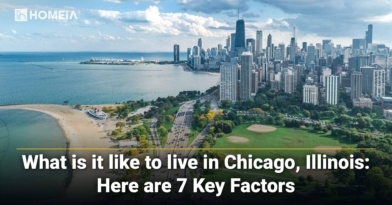The 5 Best Places to Live in Illinois: A City Comparison
- Local Editor:Local Editor: Toby Miller
Published: Oct 30, 2025
- Category: City Living Guide

Illinois is a state of remarkable contrasts between towns, villages, and cities, where world-class urban centers coexist with charming small towns and fertile farmland. Choosing the right community within the Prairie State is crucial to attaining a lifestyle that fits your ambitions.
This guide provides an in-depth, data-driven analysis of the five best places to live in Illinois in 2025. We’ve moved beyond considering simple charm to evaluate these population centers on the factors that we feel are crucial: economic opportunity, affordability, safety, access to amenities, and the quality of life. From the global energy of Chicago to the academic excellence of Urbana-Champaign, we break down what makes each city a premier destination for building your future in the Midwest.
For those considering other states, you might also explore our comparison of the pros and cons of living in Wisconsin.
Table of Contents:
Key Takeaways
- Diverse Options for Diverse Needs: These top cities each offer options distinctly different lifestyles, from the global economic engine of Chicago to the tightly-knit, high-performing community of Naperville.
- Affordability Varies Significantly: A major consideration for those looking to live in any of the five cities is the range of cost of living, with some areas offering exceptional value while others command premium prices.
- Safety and Community Quality Differ: Safety ratings and community engagement vary considerably from city to city, making it crucial to research specific neighborhoods and cities based on your personal tolerance and priorities.
- Economic Drivers Differ: Each city’s job market is anchored by different sectors—finance, technology, healthcare, education, or manufacturing—requiring alignment with your career field.
- Culture is Key: The intangible sense of place, community, and access to culture and nature are often the defining factors in choosing between these exceptional locations.
Moving to Illinois: The Complete Relocation Guide & Checklist
Illinois’ cost of living is 10% above the U.S. average, driven by housing, though utilities are cheaper. The state offers a diverse climate, strong economy across key industries, rich cultural variety from Chicago to small towns, and excellent transportation networks connecting its urban and rural communities statewide.
I. Methodology: How We Chose the Best
To ensure a comprehensive and objective ranking, our analysis is based on a multi-factor methodology that evaluates each city on key criteria that we believe are essential for high quality of life in the Illinois context.
Our evaluation criteria are weighted as follows:
- Employment & Economy (25%): Assesses job market health, major employers, economic diversity, and income levels relative to the local cost of living.
- Housing & Affordability (25%): Evaluates the median home value, average cost of rent, and home-price-to-income ratios of each city, acknowledging Illinois’s overall affordability but important local variations.
- Quality of Life & Culture (20%): This encompasses access to unique outdoor recreation, cultural attractions, dining, entertainment, and the overall lifestyle one can expect in the area.
- Access & Infrastructure (15%): Considers travel by road and air, healthcare access, internet reliability, and other critical services.
- Safety & Community (15%): Reviews crime statistics and overall community engagement, resilience, and family-friendliness.
Data is compiled from reputable 2025 sources, including the U.S. Census Bureau, Bureau of Labor Statistics, FBI crime data, and real estate market analyses (Zillow, local MLS).
The Pros and Cons of Living in Illinois (updated)
Illinois offers a diverse mix of urban and rural living, from Chicago’s skyline to peaceful farmland. The pros include culture, education, and location; cons include taxes and weather. This guide explores the pros and cons of living in Illinois to help you choose the best community for your lifestyle…
II. The 5 Best Cities: A Portrait of Illinois’s Diversity
1. Springfield: The Historic Capital
HOMEiA Score: 80/100
- Cost of Living: 10% below U.S. average
- Monthly Rent: $850
- Home price to income ratio: 3.9:1
- Income to rent ratio: 58.8x
- Safety rating: 60/100
A. Employment & Economy: As the state capital, Springfield’s economy is defined by stable government jobs. The healthcare sector is another major pillar of Springfield’s economy, supported by several major hospital systems and medical research. Manufacturing, education, and professional services round out a resilient job market that is largely immune to national economic swings, providing steady employment opportunities for Illinoisans.
B. Housing & Affordability: Springfield offers exceptional value, with the most affordable housing among Illinois’s major cities. The home-price-to-income ratio is an excellent 3.9:1. Its market provides a mix of beautiful historic homes in established neighborhoods and newer subdivisions, all at very economical prices. The cost-of-living advantage makes it attractive for young professionals and families.
C. Quality of Life & Culture: Life in Springfield is defined by its rich history, political significance, and Midwestern charm. The city boasts numerous Lincoln historical sites that students and history enthusiasts come from all over to visit, beautiful parks, and a growing downtown restaurant scene. The community balances state government duties with small-town accessibility and family-friendly amenities.
D. Access & Infrastructure: Well-connected via I-55 and I-72, Springfield has a regional airport (SPI) and Amtrak service to Chicago and St. Louis. The city has comprehensive healthcare facilities and major retail options, providing all the conveniences of state capital living while maintaining its manageable scale.
E. Safety & Community: With a safety rating of 60/100, Springfield has a mix of comfortable neighborhoods and areas that struggle economically. The community of Springfield is welcoming, with a strong sense of identity tied to its political history and state government role. The population is a blend of government workers, healthcare professionals, and multi-generational families.
Recommended for you
2. Chicago: The Global Metropolis
HOMEiA Score: 82/100
- Cost of Living: 15% above U.S. average
- Monthly Rent: $2,100
- Home price to income ratio: 6.8:1
- Income to rent ratio: 42.9x
- Safety rating: 45/100
A. Employment & Economy: Chicago is Illinois’s economic engine and a global financial hub. It functions as the headquarters for major corporations in finance, manufacturing, technology, and professional services. The city boasts a diverse economy with strong healthcare, education, and tourism sectors. This is why it has the state’s most dynamic job market, with the highest concentration of professional opportunities and international business connections.
B. Housing & Affordability: Chicago offers a diverse housing stock, from luxury high-rises along the Magnificent Mile to historic brownstones in neighborhood communities. The home-price-to-income ratio is 6.8:1. While more expensive to live in than downstate cities, it remains competitive compared to other global cities, such as New York or San Francisco. The market provides options for every situation, though competition can be fierce for desirable properties in trendy neighborhoods.
C. Quality of Life & Culture: Chicago provides an unparalleled city-living experience with world-class museums, theaters, restaurants, and 26 miles of lakefront parks. One can spend time in Millennium Park within minutes of leaving a downtown office. The city has a vibrant and evolving restaurant scene, beautiful historic architecture, and major cultural institutions like the Art Institute and the Field Museum of Natural History that one can visit. Professional sports teams across all major leagues call it home, too!
D. Access & Infrastructure: Serving as the most connected city in Illinois, it has two international airports (O’Hare and Midway), extensive public transportation (CTA), and hospitals from major healthcare systems. Some areas have robust infrastructure, while others face challenges due to aging infrastructure. It serves as the commercial and logistical hub for the entire Midwest region.
E. Safety & Community: With a safety rating of 45/100, safety varies significantly by neighborhood. Areas around Lincoln Park and North Center are considered family-friendly, while the South and West Sides experiencechallenges due to a history of racial discrimination in housing Whet Moster “interview[ed] “historian Elaine Lewinnek” about this, and Lewinnek stated that Chicago officials initially “wanted to build public housing in poor white areas as well as poor black areas,” but in the end, “very little public housing was built in white areas. Public housing became black housing, and hurt an entire group of people.” She further states that “we didn’t have to inherit this,” likely referring to the community of Chicago (Moser quoting Lewinnek). The population is highly diverse and transient, but strong neighborhood identities create tight-knit communities throughout the city.
7 Most Affordable Places to Live in Illinois
Illinois offers more than its big cities and farmland—it’s also one of the Midwest’s most affordable states. With low median home prices and a diverse economy, it attracts families, retirees, and remote workers alike. This guide reveals seven budget-friendly Illinois communities for 2025, balancing cost, comfort, and Midwestern charm.
3. Champaign-Urbana: The Academic Powerhouse

HOMEiA Score: 84/100
- Cost of Living: 5% below U.S. average
- Monthly Rent: $950
- Home price to income ratio: 4.8:1
- Income to rent ratio: 52.6x
- Safety rating: 65/100
A. Employment & Economy: Champaign-Urbana’s economy is dominated by the University of Illinois at Champaign-Urbana, which creates a stable mix of education, research, and healthcare employment in the area. As home to one of the nation’s top public research universities, the city benefits from a steady stream of jobs in academia, technology transfer, and extension services. The Research Park hosts numerous tech startups and corporate R&D centers, providing resilience and innovation to the local economy.
B. Housing & Affordability: Champaign-Urbana offers the best balance of affordability and amenities among Illinois’s larger cities. The home-price-to-income ratio is a healthy 4.8:1. Its market provides a mix of historic homes near campus and newer subdivisions, all at economical prices for students, faculty, and young professionals. Its cost of living, at 5% below average, is a major draw.
C. Quality of Life & Culture: Life in Champaign-Urbana is defined by intellectual engagement and Big Ten energy. The university brings youthful vitality, cultural events, and Division I athletic teams to the city. It boasts a vibrant downtown area with diverse dining options, independent bookstores, and a strong arts scene. The community balances academic rigor with Midwestern charm and accessibility.
D. Access & Infrastructure: Well-connected via I-57 and I-74, Champaign-Urbana has a regional airport (CMI) and Amtrak service to Chicago. The city has well-regarded hospital systems and major retail chains, providing all the conveniences of a larger city while maintaining its college town character.
E. Safety & Community: With a safety rating of 65/100, Champaign-Urbana has comfortable neighborhoods and areas that experience typical college town challenges. The community is welcoming, with a strong sense of identity tied to its academic mission and agricultural roots. The population is a blend of students, faculty, and multi-generational families.
7 Key Factors to Know About Living in Chicago, Illinois
Before you consider a move to Chicago, you should consider 7 key factors that will increase your appreciation for the city and guide you to the right neighborhoods and activities for you…
4. Evanston: The Lakeside Intellectual Hub

HOMEiA Score: 86/100
- Cost of Living: 20% above U.S. average
- Monthly Rent: $1,800
- Home price to income ratio: 7.2:1
- Income to rent ratio: 55.6x
- Safety rating: 70/100
A. Employment & Economy: Home to Northwestern University, Evanston’s economy is dominated by stable education and healthcare jobs. The other major pillar is the professional services economy, supported by the university’s research enterprise and proximity to Chicago. Healthcare, technology, and an evolving corporate sector round out a unique and robust job market that is largely insulated from broader economic swings.
B. Housing & Affordability: Evanston is considered a more expensive housing market in Illinois. The home-price-to-income ratio is 7.2:1, reflecting high demand from academics and professionals. Limited buildable land and historical preservation laws constrain supply and increase costs, but the market is highly competitive. This is especially true for homes close to the lakefront and university campus.
C. Quality of Life & Culture: Evanston offers an unparalleled blend of intellectual culture, lakeside beauty, and urban accessibility. From the stunning Lake Michigan shoreline to the downtown packed with independent shops and award-winning restaurants, it boasts a sophisticated, cosmopolitan vibe centered around education and the arts, all while maintaining its historic architectural charm. Neighborhoods in Evanstown have well-groomed, lush greenery and flowers which complement the homes and buildings that they surround, without overshadowing their beauty. Even the university hospitals have a well-maintained, home-like feeling about them due to how well-maintained the buildings and surrounding gardens are.
D. Access & Infrastructure: Evanston has excellent public transportation connections to Chicago via Metra and CTA, and is just 12 miles from the Loop. It has pristine healthcare facilities for its size and a walkable, pedestrian-friendly downtown area. Traffic congestion can be an issue during peak commuting hours.
E. Safety & Community: With a safety rating of 70/100, Evanston has a strong sense of community and a safety profile that is better than many similar-sized cities. The community is filled with individuals who are educated, engaged, and environmentally conscious. Its population blends university affiliates, long-time residents, and Chicago commuters.
What to Know About Parking in Chicago, Illinois
Drivers need to know which options are available, what the rules and regulations say about parking, and where to go when traveling with a car. Knowing these things will mitigate any potential issues that arise. Luckily, Chicago has many options for people who know where to look…
5. Naperville: The Premier Suburb
HOMEiA Score: 88/100
- Cost of Living: 25% above U.S. average
- Monthly Rent: $2,300
- Home price to income ratio: 4.2:1
- Income to rent ratio: 78.3x
- Safety rating: 85/100
A. Employment & Economy: Naperville’s prime strength is its proximity to Chicago’s robust economy while maintaining its own corporate presence. Residents can choose a 30-45 minute commute to the city’s highest-paying jobs, while benefiting from local employment at major corporations like BP, Nicor, and Edward Hospital. Naperville has a growing technology and healthcare sector that serves its affluent population, creating a stable and prosperous economic environment.
B. Housing & Affordability: As a premier suburb, Naperville offers newer homes, excellent schools, and modernized infrastructure at premium prices. The high median income results in a home-price-to-income ratio of 4.2:1, indicating ideal purchasing power for residents. The market contains a mix of historic homes near downtown and newer subdivisions, all maintaining high property values and strong appreciation.
C. Quality of Life & Culture: Naperville offers a pristine, convenient, and family-centric lifestyle. It features the renowned Riverwalk, excellent local parks, diverse dining options, and access to the cultural amenities of Chicago without sacrificing peace and quiet. It provides instant access to all the amenities of a major metropolis while maintaining a strong sense of community and suburban comfort.
D. Access & Infrastructure: Fully integrated into the metropolitan area, Naperville enjoys smooth roads, reliable utilities, and top-notch emergency services. It also has seamless connectivity to Chicago via Metra commuter rail and major highways, while maintaining its own distinct identity. The city boasts excellent public services and its infrastructure is well-maintained.
E. Safety & Community: With a safety rating of 85/100, Naperville is consistently ranked one of the safest cities in Illinois. The city boasts low crime rates, beautifully maintained properties, and a strong, engaged community focused on family life, youth sports, and community events. For those considering other states with great schools, explore the best places to live in Michigan.
Comparative Data Table
City | HOMEiA Score | Cost of Living | Avg. Rent (2-Bed) | Home Price to Income Ratio | Income to Rent Ratio | Safety Rating |
|---|---|---|---|---|---|---|
| Springfield | 80 | -10% | $850 | 3.9:1 | 58.8x | 60 |
| Chicago | 82 | +15% | $2,100 | 6.8:1 | 42.9x | 45 |
| Champaign-Urbana | 84 | -5% | $950 | 4.8:1 | 52.6x | 65 |
| Evanston | 86 | +20% | $1,800 | 7.2:1 | 55.6x | 70 |
| Naperville | 88 | +25% | $2,300 | 4.2:1 | 78.3x | 85 |
Conclusion: Finding Your Perfect Illinois Match
The best Illinois city for an individual to live in is subjective. Chicago delivers global energy and diverse careers, while Springfield offers historic sites and affordability. Naperville promises safety and excellent schools for families, and Evanston provides intellectual culture in a stunning lakeside setting. Champaign-Urbana offers academic excellence and innovation for those in its specialized economy.
Each location presents a unique trade-off between cost, opportunity, and lifestyle. Your ideal choice hinges on aligning these factors with your personal, financial, and professional goals for life in Illinois. For those still considering options, our guide to the best places to live in Wisconsin might provide additional insights for Midwestern living.
Recommended for you
FAQs About Living in Illinois’s Best Cities
1. Which city has the best job market? Chicago has the largest, most diverse, and most dynamic job market in the state, spanning finance, technology, healthcare, and professional services. Naperville offers proximity to Chicago’s opportunities, but has its own corporate presence. It also has excellent local employment opportunities.
2. I’m a remote worker. Where should I move? For the best blend of reliable infrastructure, amenities, and culture, Evanston is a fantastic choice. For more affordable living with reliable internet and access to a metropolis, consider Champaign-Urbana or Springfield. Always confirm internet reliability at your specific address before moving.
3. Are these cities safe? Safety varies significantly. Naperville is generally considered the safest (85/100), followed by Evanston (70/100). Chicago (45/100) has protected suburbs and areas to be cautious in. . Always research specific neighborhoods before choosing to move.
4. What’s the best city for young professionals? Chicago offers the most vibrant social scenes, networking opportunities, and diverse career paths for young professionals. Champaign-Urbana offers an economical, intellectually stimulating alternative with youthful energy from its university.
5. What’s the best city for families? Families often choose based on schools and safety. Naperville offers some of the best schools and highest safety rating (85/100) but comes with premium costs. Champaign-Urbana provides excellent schools and a family-friendly environment at a more affordable price point, and also has a good safety rating (65/100).
For those exploring other Midwestern options, you might also consider the pros and cons of living in Indiana or discover the best places to live in Ohio. If you’re interested in more affordable options, check out our guide to the most affordable places to live in Ohio or learn about what it’s like to live in Chicago. For those considering the Great Lakes region, explore the best places to live in Michigan or learn about the pros and cons of living in Michigan.
Toby Miller lives in Illinois. He is a freelance editor and content writer who has lived in the Prairie State his whole life. He is happily engaged and love marathoning movies with his fiancé and their snuggly cats. He is also a Graphic Design major who loves turning visuals into stories. Between his college studies and work, Toby often checks out more books than he can carry from the library. Toby has experience providing editorial feedback on nonfiction work, like memoirs and articles, and fictional pieces like plays. He enjoys researching to find the best solutions for his projects and treats each editorial project with attention and passion.
HOMEiA is a city guide site where visitors can find detailed information about communities of interest. HOMEiA’s City Guides, created in partnership with local writers and editors, are curated lists of the best, safest, and most affordable places to live. The guides feature the HOMEiA Score, a proprietary index that rates communities on such factors as housing costs, education, employment, etc.
HOMEiA.com aims to be the premier site for people planning to relocate, providing them with insightful content and connecting them with skilled real estate professionals.
We also empower real estate professionals to establish or strengthen their web presence by highlighting their experience, knowledge and achievements. If you’re selected to join our list of certified real estate professionals, you will distinguish yourself from your peers — and earn HOMEiA’s support.
If you believe in HOMEiA’s mission, please share our website with others.









































































































































